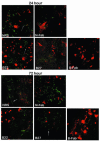OspB antibody prevents Borrelia burgdorferi colonization of Ixodes scapularis
- PMID: 14977984
- PMCID: PMC356050
- DOI: 10.1128/IAI.72.3.1755-1759.2004
OspB antibody prevents Borrelia burgdorferi colonization of Ixodes scapularis
Abstract
Borrelia burgdorferi outer surface protein OspB is expressed by spirochetes in the Ixodes scapularis gut. ospB is transcribed from a bicistronic operon with ospA, a known spirochete adhesion gene in the tick gut. Here we examine whether OspB also has a specific function in ticks. OspB specifically binds to a protein or protein complex within the tick gut. We also assessed whether selected nonborreliacidal OspB antibodies or F(ab)(2) fragments interfere with B. burgdorferi-tick attachment in vivo. We examined engorged ticks that fed on B. burgdorferi N40-infected scid mice that had been treated with OspB F(ab)(2) fragments. Control F(ab)(2) fragments did not interfere with B. burgdorferi colonization of the tick gut, whereas OspB F(ab)(2) fragments significantly inhibited the attachment of spirochetes to the tick gut. These studies show that nonbactericidal OspB antibodies interfere with B. burgdorferi colonization of I. scapularis, highlighting a specific role for OspB in spirochete- arthropod interactions and suggesting new antibody-mediated strategies for interfering with B. burgdorferi transmission.
Figures




Similar articles
-
Outer surface protein B is critical for Borrelia burgdorferi adherence and survival within Ixodes ticks.PLoS Pathog. 2007 Mar;3(3):e33. doi: 10.1371/journal.ppat.0030033. PLoS Pathog. 2007. PMID: 17352535 Free PMC article.
-
Inhibition of Borrelia burgdorferi-tick interactions in vivo by outer surface protein A antibody.J Immunol. 2001 Jun 15;166(12):7398-403. doi: 10.4049/jimmunol.166.12.7398. J Immunol. 2001. PMID: 11390491
-
Borrelia burgdorferi OspA is an arthropod-specific transmission-blocking Lyme disease vaccine.J Exp Med. 1996 Jan 1;183(1):271-5. doi: 10.1084/jem.183.1.271. J Exp Med. 1996. PMID: 8551231 Free PMC article.
-
Vaccination against Lyme disease: past, present, and future.Front Cell Infect Microbiol. 2013 Feb 12;3:6. doi: 10.3389/fcimb.2013.00006. eCollection 2013. Front Cell Infect Microbiol. 2013. PMID: 23407755 Free PMC article. Review.
-
Lyme borreliosis vaccination: the facts, the challenge, the future.Trends Parasitol. 2011 Jan;27(1):40-7. doi: 10.1016/j.pt.2010.06.006. Epub 2010 Jun 30. Trends Parasitol. 2011. PMID: 20594913 Review.
Cited by
-
The Emerging Role of Microbial Biofilm in Lyme Neuroborreliosis.Front Neurol. 2018 Dec 3;9:1048. doi: 10.3389/fneur.2018.01048. eCollection 2018. Front Neurol. 2018. PMID: 30559713 Free PMC article. Review.
-
Ehrlichia chaffeensis expresses macrophage- and tick cell-specific 28-kilodalton outer membrane proteins.Infect Immun. 2005 Jan;73(1):79-87. doi: 10.1128/IAI.73.1.79-87.2005. Infect Immun. 2005. PMID: 15618143 Free PMC article.
-
Borrelia burgdorferi surface protein Lmp1 facilitates pathogen dissemination through ticks as studied by an artificial membrane feeding system.Sci Rep. 2018 Jan 30;8(1):1910. doi: 10.1038/s41598-018-20208-4. Sci Rep. 2018. PMID: 29382879 Free PMC article.
-
Outer surface protein B is critical for Borrelia burgdorferi adherence and survival within Ixodes ticks.PLoS Pathog. 2007 Mar;3(3):e33. doi: 10.1371/journal.ppat.0030033. PLoS Pathog. 2007. PMID: 17352535 Free PMC article.
-
Reviewing molecular adaptations of Lyme borreliosis spirochetes in the context of reproductive fitness in natural transmission cycles.Vet Res. 2009 Mar-Apr;40(2):36. doi: 10.1051/vetres/2009019. Epub 2009 Apr 16. Vet Res. 2009. PMID: 19368764 Free PMC article. Review.
References
-
- Brunet, L. R., A. Spielman, E. Fikrig, and S. R. Telford, 3rd. 1997. Heterogeneity of Lyme disease spirochaetes within individual vector ticks. Res. Microbiol. 148:437-445. - PubMed
Publication types
MeSH terms
Substances
LinkOut - more resources
Full Text Sources

